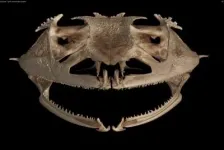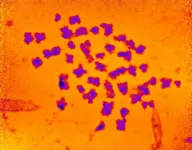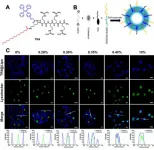(Press-News.org) A college education is estimated to add $1 million to a person's lifetime earning potential, but for some students the path to earning one is riddled with obstacles. That journey is even more difficult for students who have been in the foster care system or experienced homelessness, according to a new study from the University of Georgia.
But the more college administrators and faculty know about these students' problems, the more they can do to ease the burden.
Getting into universities in the first place can frequently be a challenge for students who've had unstable home lives, said David Meyers, co-author of the study.
"Research tells us that every time a student moves from one foster care placement to another, they lose six months of educational progress," said Meyers, a public service associate in the J.W. Fanning Institute for Leadership Development. "That's a pretty serious setback. It's a challenge for them to participate in after-school activities or athletics. Their college resume is not going to be as strong as those students who don't face those same challenges."
It's a similar struggle for students who've experienced homelessness. For those who beat the odds, getting into college is just the start of a whole new set of hurdles. The added stressors of having to figure out how to pay for courses, books and housing once they get there--something many of their classmates don't have to think about--take a tremendous toll.
"Having to act like an adult when you're still a kid presents huge challenges for students trying to get into college," said Kim Skobba, co-author of the paper and an associate professor in the College of Family and Consumer Sciences. "But then when you get to college, you're still on your own."
Entirely on their own
The study, published in the Journal of Adolescent Research, focuses on the experiences of 27 college students, all attending four-year institutions, who had been in foster care, experienced homelessness or both. The researchers conducted a series of three in-depth interviews with each participant over the course of one academic year, and several clear themes emerged.
These students all had to "get by" largely on their own. They often were without parental guidance or support during high school, and in college they were entirely on their own. Many took jobs, sometimes going to school full time while also working full or nearly full-time hours.
One student described having six classes while also working 40 hours a week, saying, "I kept breaking down. ... I was staying up to about 2 or 4 in the morning doing homework and waking up at 7." (This type of experience was more common among students who had been homeless than those who were in foster care at the time of their high school graduation.)
One of the biggest expenses for all the students in the study was paying for and maintaining stable housing. Eleven of them experienced at least one period of homelessness since beginning college, living in their cars or couch surfing.
Another constant issue was finding money for books and food. Even with scholarship support, many of the students would ask professors whether the book was essential for success in their course and if so would borrow a friend's book or even one of the professor's copies, if possible.
Perhaps not surprisingly, these stressors made it difficult for students to focus on their academics.
"It takes a mental and emotional toll on these students," Meyers said. "We think about it in financial terms, but it really, I think, also shows up in sort of this constant emotional challenge. Being thoughtful, being vigilant, never really having the luxury of being able to set it aside."
Finding solutions
Institutions like UGA are taking steps to address this issue, with programs that provide emotional support while connecting students to resources they might otherwise not know exist.
Embark@UGA, for example, is the campus-based component of Embark Georgia, an effort led by Meyers and Lori Tiller, a colleague at the Fanning Institute. The program is a statewide network that connects the University System of Georgia and Technical College System of Georgia to the Division of Family and Children Services, the Georgia Department of Education, and numerous nonprofit and community organizations seeking to increase college access and retention for students who have experienced foster care or homelessness.
Through Embark, each USG university and technical college campus and every high school in Georgia has a point of contact to help identify and provide resources to homeless and former foster students who need help.
Additionally, scholarships like Let All the Big Dawgs Eat, which provides a food stipend for students, have also helped narrow the gap. UGA also has made a point to start using free online textbooks in many courses.
But not all schools have the same resources.
"Expanding programs at the federal level that would serve students who've been in foster care or homeless would really help close that gap," Skobba said. "We also don't want them taking out huge loans because that's not a good financial situation long term. And some kind of financial aid grant program serving this group would make a huge difference."
Another big help? Understanding and awareness from professors that not all students are able to spend hundreds of dollars on textbooks or don't have a personal laptop to use for class assignments.
"I think I was already a pretty flexible understanding professor, but just realizing that if you're working 40 hours because that's what it takes to stay in school, some things are going to drop from time to time," Skobba said. "Having a little bit of breathing room in your syllabus and assignments is probably beneficial to all students, but it's going to be especially helpful for this group of students."
INFORMATION:
Diann Moorman, associate professor in the College of Family and Consumer Sciences, is also a co-author on the study.
In recent months, more than three hundred cases of salmonellosis have occurred in various European countries and Canada, which are linked to each other. In the UK the cases could be partly traced back to frozen breaded poultry meat. The cause was contamination with the bacterium Salmonella Enteritidis, which causes gastrointestinal inflammation. Salmonella is not killed by deep freezing and can remain infectious at temperatures below zero degrees Celsius. The Robert Koch Institute (RKI) and the BfR are monitoring the situation together with the Federal Office of Consumer Protection and Food Safety (BVL). In Germany, the number of reported cases has currently ...
GAINESVILLE, Fla. --- Scientists have long known that frogs are oddballs when it comes to teeth. Some have tiny teeth on their upper jaws and the roof of their mouths while others sport fanglike structures. Some species are completely toothless. And only one frog, out of the more-than 7,000 species, has true teeth on both upper and lower jaws.
Now, the first comprehensive study of tooth evolution in frogs is bringing the group's dental history into focus. Florida Museum of Natural History researchers analyzed CT scans of nearly every living amphibian genus to reveal that frogs have lost teeth over 20 times during their evolution, more than any ...
DANVILLE, Pa. - Among people who have strokes and COVID-19, there is a higher incidence of severe stroke as well as stroke in younger people, according to new data from a multinational study group on COVID-19 and stroke, led by a team of Geisinger researchers.
The COVID-19 Stroke Study Group's latest report, published in the journal END ...
LAWRENCE -- In the early days of COVID-19 vaccine development, a new social media platform provided a place for like-minded people to discuss vaccines, share misinformation and speculate about the motivations for its development. A new study from the University of Kansas shows people flocked to Parler to discuss the vaccines in an echo chamber-type environment, and those conversations can shed light about how to communicate about vaccine efficacy during health crises.
COVID-19 vaccine vial and syringe photo from the U.S. Census Bureau.In the runup to the 2020 election, then-president Donald Trump claimed a COVID-19 vaccine could be ready before ...
Mass of human chromosomes measured for the first time
The mass of human chromosomes, which contain the instructions for life in nearly every cell of our bodies, has been measured with X-rays for the first time in a new study led by UCL researchers.
For the study, published in Chromosome Research, researchers used a powerful X-ray beam at the UK's national synchrotron facility, Diamond Light Source, to determine the number of electrons in a spread of 46 chromosomes which they used to calculate mass.
They found that the chromosomes were about 20 times ...
Scientists have revealed a potential mechanism for how traumatic brain injury leads to neurodegenerative diseases, according to a study in fruit flies, and rat and human brain tissue, published today in eLife.
The results could aid the development of treatments that halt the progression of cell damage after brain injury, which can otherwise lead to neurological diseases such as amyotrophic lateral sclerosis (ALS), and Alzheimer's and Parkinson's disease.
Repeated head trauma is linked to a progressive neurodegenerative syndrome called chronic ...
Since the introduction on the market in 1995 of Doxil, pegylated liposomal doxorubicin, liposomes have become one of the most clinically established drug delivery systems in nanomedicine. Among different liposomal formulations, cationic liposomes have attracted great attention because of their capacity to bind negatively charged nucleic acids to perform as non-viral gene delivery tools, and due to their potentials to fuse with cell membranes leading to a direct release of cargoes from liposomes into the cytoplasm and high drug delivery efficiency. However, in most cases, the drug/gene delivery and therapeutic efficacy by cationic liposomes are evaluated ...
A new study led by Kent Business School, University of Kent, finds that whilst the mumpreneur identity may enable women to participate in the business world and be recognised as 'proper' entrepreneurs, this success is dependent on alignment with the conventional masculine norms of entrepreneurship.
These conventional masculine behaviours include working long hours and an ongoing dedicated commitment to the success of a business.
Published in the International Small Business Journal and based on an interview study of women business owners, the study highlights the interviewees' belief that entrepreneurship and motherhood ...
Firefighting is a race against time. Exactly how much time? For firefighters, that part is often unclear. Building fires can turn from bad to deadly in an instant, and the warning signs are frequently difficult to discern amid the mayhem of an inferno.
Seeking to remove this major blind spot, researchers at the National Institute of Standards and Technology (NIST) have developed P-Flash, or the Prediction Model for Flashover. The artificial-intelligence-powered tool was designed to predict and warn of a deadly phenomenon in burning buildings known as flashover, when flammable materials in a room ignite almost simultaneously, producing a blaze only limited in size by available oxygen. The tool's predictions are ...
EUGENE, Ore. -- June 1, 2021 -- Businesses typically rely on banks and financial markets for financing, but credit provided by suppliers also can play an important role, especially in manufacturing. Yet why firms lend and borrow extensively from each other is still an open question.
In a paper online ahead of print in the Journal of Financial Economics, "Trade Credit and Profitability in Production Networks," Youchang Wu, an associate professor at the University of Oregon, and coauthor Michael Gofman, an assistant professor at the University of Rochester, examined trade credit from a new angle.
They noted that for an average nonfinancial firm in North America, the outstanding amount of trade credit it receives from suppliers is about 21 percent of annual production costs. Moreover, ...



